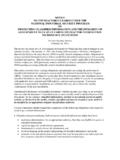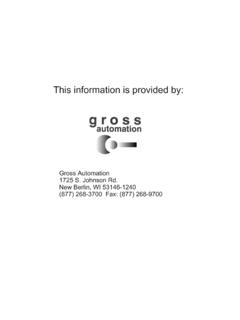Transcription of Information Provided by the Qualitative Reading Inventory-5
1 3 Information Provided by the Qualitative Reading Inventory-5 . Finding Reading Levels Questions Regarding the Validity and Reliability Identifying Reading Levels of QRI-5. The Independent Level Inter-Scorer Reliability The Instructional Level Alternate-Form Reliability The Frustration Level Reliability of Diagnostic Judgments Level Variety Concurrent Validity Construct Validity Determining Reader Strengths and Needs Classification Validity Documenting Growth and Change FINDING Reading LEVELS. The Qualitative Reading Inventory-5 can be used to provide appropriate Information in three areas: 1. To identify a student's instructional level 2. To determine areas of Reading in which the student is having difficulty 3.
2 To document growth based on a type of instructional program or intervention Identifying Reading When used to determine a student's Reading levels, the QRI-5 can help find the levels Levels at which a student can read independently, read with instructional guidance, and read with frustration. The QRI-5 can also be used to determine if a student's Reading levels are below his or her chronological grade level. The Independent This is the level at which a student can read successfully without assistance. Oral Reading Level should be fluent and free from behaviors such as finger pointing and overt signs of ten- sion. The student's accuracy in word recognition while Reading orally should be 98% or higher.
3 Silent Reading should also be free from finger pointing. For both oral and silent Reading , comprehension should be excellent. The reader should be able to answer 90%. or more of the questions correctly. An examiner should choose materials written at this level for the student's free- Reading pleasure or for tasks that the reader is expected to perform independently. It is also wise to choose materials at an independent level for Reading -strategy instruction or fluency practice. This allows the reader to learn and practice a strategy on relatively easy text before transferring to more challenging material. 22. The Instructional This is the level at which a student can read with assistance from a teacher.
4 Both oral Level and silent Reading should be free from behaviors that often indicate serious difficulty, such as finger pointing or tension. Although oral Reading may be less fluent at this level than at the independent level, it should retain some sense of rhythm and expression. The examiner should use a criterion of 95% accuracy when counting only those miscues that changed the meaning of the passage. Our pilot data revealed that 95% Acceptable Accuracy best predicts comprehension at the instructional level. The examiner who is counting all miscues should use a criterion of 90% accuracy, and the student should correctly answer 70% of the questions asked.
5 Materials written at this level should be chosen for Reading and content-area instruc- tion. This placement assumes that the teacher will introduce words and concepts that are likely to be unfamiliar to the readers. She or he presents the identification and mean- ing of these concepts and provides appropriate background knowledge necessary for understanding the material. Obviously, when students are placed at the instructional level, the teacher should not say, Read Chapter 5 and we'll have a test tomorrow.. A student's instructional level, once determined, can be compared to the student's chronological grade placement. Is it below the level of materials that are appropriate for that grade level?
6 Such Information will allow the examiner to estimate the severity of a Reading problem. Assessment specialists once believed that a student had a Reading prob- lem if there was a substantial difference between expectancy level or Reading potential and instructional level with familiar material. Expectancy level or Reading potential was gener- ally based on IQ; however, this practice has been seriously questioned (Aaron, 1997). The reauthorization of the Individuals with Disabilities Education Act (2004) conceptualizes Reading problems in terms of lack of response to instruction and it may be more appropri- ate to talk of serious Reading problems in terms of a discrepancy between the student's Reading level and his or her chronological grade level.
7 Spache (1981) described severe Reading problems as follows: The problem is severe if a first, second, or third grader is a year or more behind or if a fourth, fifth, or sixth grader is two or more years behind. For students in seventh grade and above, a severe problem means three or more years behind their grade level. The Frustration Level At this level, the student is completely unable to read the material with adequate word identification or comprehension. Signs of difficulty and tension are evident. Oral read- ing lacks fluency and expression; a word-for-word, halting style is common. Accuracy of word recognition is less than 90%, and less than 70% of the questions are answered correctly.
8 Teachers should avoid materials at this level. Level Variety Although once common, it is now simplistic to talk about a single independent, instruc- tional, or frustration level for an individual. The act of Reading is highly complex and contextual. When students possess extensive prior knowledge about a topic, they can read and comprehend at a higher level than when dealing with unfamiliar material. This is well illustrated by the difficulty that mature readers often have with an income tax form or the language of an insurance policy. Text structure also affects a student's Reading ability. The diverse structure and concept density of expository material makes it more difficult to comprehend than narrative text.
9 Whether a student reads orally or silently can affect comprehension, depending on the age of the student. Younger, less-fluent readers generally do better in oral Reading , whereas older readers are often constrained Finding Reading Levels 23. by the performance aspect of oral Reading , and their comprehension suffers accordingly. The variety of passages in the Qualitative Reading Inventory-5 allows the examiner to evaluate the effects of background knowledge, text structure, and Reading mode on the independent, instructional, and frustration levels of the reader. It is not inconceivable that a single reader may have different levels for familiar and unfamiliar text, for nar- rative and expository material, and for oral and silent Reading modes.
10 The presence or absence of pictures may affect performance. Levels may also vary depending on whether the examiner is assessing comprehension with or without look-backs. A student may be at a frustration level for answering questions without referring to the text but may achieve an instructional level when allowed to utilize the look-back strategy. Which Reading level is most important? Given the constraints of time, few examiners would be able to determine all possible Reading levels that a student might have. Based on individual purposes and needs, each examiner will have to choose which Reading level to isolate for a given student. Which level best estimates the overall Reading ability of the student?















